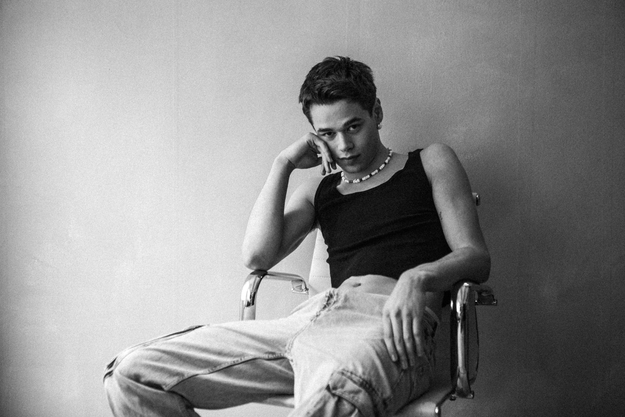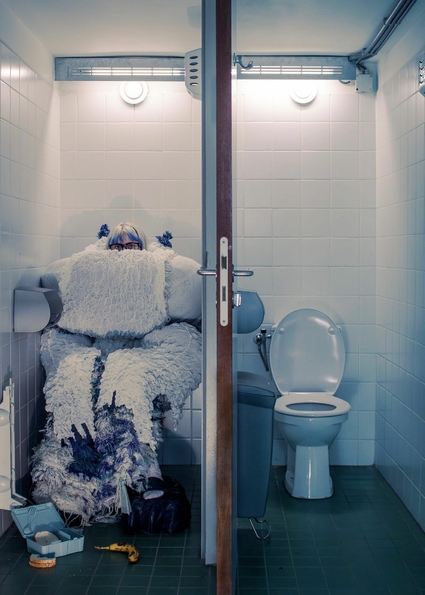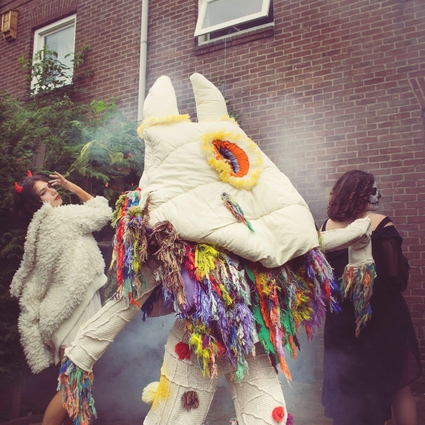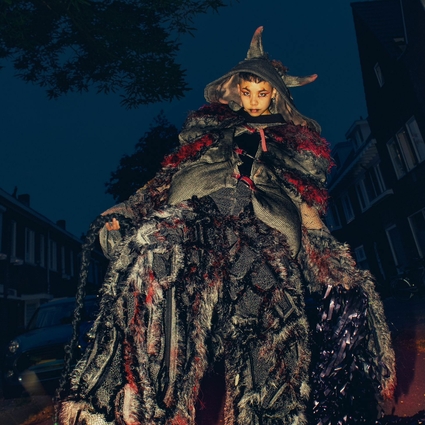Q: To start, can you tell us a bit about yourself and your journey as an artist / costume designer so far?
A: Well, when I was growing up, I always had a knack for the arts. I loved to draw, paint, anything creative, and I loved dressing up. It could be in my sister's Cinderella dresses, or anything else like that! Then, as I got older, I started getting into other things like playing soccer with friends and just being outdoors. I feel like I was forgetting my creative side. Of course at home, creativity was still there, but it wasn't my main focus.
In high school, I realized my main interests were either sports or arts. It's funny how different they are yet still connected. By the end of high school, I had to decide what direction to take in life. Did I want to pursue something creative, where I'd always feel stimulated and surrounded by creative people? Or did I want to focus on sports, where it's all about physical performance?
For me, the creative world seemed much more fulfilling. So, I chose to go to Design Academy Eindhoven. It was the first school that I applied to and I wasn't sure what I wanted to specialize in. I considered architecture, product design, furniture design, jewelry making, fashion—basically, everything. Luckily, my school allowed exploration in the first year. I tried different arts, and even then, I still wasn't entirely sure. I went into fashion design, product design, and social design. I learned so much from the different disciplines and mediums, and brought them into my practice. With social design, it taught me new ways of connecting with more people and my work. Eventually, I circled back to fashion design and realized that that was really where my interest lies. I love telling stories through clothing and how it interacts with the body.
Q: It's really interesting to hear that sport was such a big part of your life as well. Do you feel that those experiences have influenced the way you perceive aspects of fashion, and how you approach the body and styling?
A: I think so, yes. The movement of garments is something I find very interesting. There's a direct link between the movement of the body in sports and how clothing moves with it. But it's not necessarily about sportswear itself; it's more about the idea of body movement. When I'm selecting models for my shoots or designing costumes, I focus on how the body is moving in it. I consider how a character would move in the costume—whether they're quick, slow, or expressive. This performative aspect of fashion is where I see the merging of sports and fashion, as both involve a sense of performance.
Q: Could you tell us about your graduation project, 'Monsters under the bed'? What was your inspiration? How do you translate the concept of celebrating otherness into your costume designs, particularly in the context of childhood monsters?
A: Well, first, it's important to understand where the inspiration for the monsters comes from. Growing up, I was fascinated by weird, bizarre animals, as well as shows like Monster Inc, Sesame Street, and scary movies featuring intriguing monsters. Everything I drew existed within this fantastical realm of what a monster could be. Initially, I thought it was because they looked super cool and had these weird, big volumes and weird places that were so otherworldly. In high school, I realized it was also a way for me to escape, so I'd always be doodling and such of monsters, or the idea of a teacher turning into a monster.
The inspiration for the monsters comes from this idea that while some people are repulsed by them and find them scary, I'm intrigued by what they are, what story they hold. I found this perspective fascinating and thought it might be a path worth exploring for my graduation project. Reflecting on whether I've ever felt like a monster or an outsider in my life, I realized that starting in high school, as a young kid, I felt this pressure to conform. Primary school was very liberal, where you could wear whatever you wanted, but high school was policed and censored. I felt the decline of color and self-expression during my first week. It felt like I was being told to just act like everyone else, and that was challenging for me.
Q: You designed three costumes, each representing a different monster. Could you share with us what that process was like, and what each monster represents?
The first monster represents the sadness of not being able to break free from societal norms, despite wanting to. It felt like every time I tried to step out of the box, I was pushed back.
My second monster represents the first time I defied these constraints and was met with acceptance. It symbolizes the freedom to express myself authentically and the joy of being celebrated for who I am. This newfound sense of liberation is depicted as an explosion of color, breaking free from suppression.
The third monster embodies pride and self-assurance. It signifies embracing one's identity without fear of judgment or derogatory remarks. It's about confidently navigating the world, knowing that being true to oneself is empowering, not a weakness.
Overall, my 'Monster Under the Bed' collection explores themes of self-acceptance, societal pressures, and the journey to embracing one's uniqueness. It reflects my belief that embracing our differences and celebrating individuality is empowering and liberating.
Q: On April 15th, you will be presenting at our upcoming A/artist event and speaking about your work. What reflections or discussions do you hope audiences engage in after your talk?
A: I really hope that people come with their own stories and start to open up a discussion where every single person in the room shares moments when they've felt like the 'monster' of a situation. I'm not referring to instances where someone is genuinely being monstrous, but rather those moments when simply because someone doesn't understand a certain part of you, you've been labeled as the 'monster' or feared. I want to engage in these types of discussions where emotions are shared openly. I want to share my experiences and hear how others respond to them.
Additionally, if anyone has questions about any creative process, I'm open to discussing that as well. I find conversations much more engaging than just delivering a monologue. I wanted to sort of tell my story, wanting it to become a story.
Q: Could you share some of the responses you've received to the project so far? After your graduation show, were there any conversations that stood out to you?
A: I had two very interesting conversations that I remember vividly. One of them was somewhat negative, but still very hilarious to me. It was with a woman who approached me and asked, 'So what's this?' I explained the story behind my project, and she responded, 'I get it. I get it. But this one,' pointing to a monster, 'is too scary, too scary.' It was clear she found it intimidating. It was funny to me because her reaction perfectly aligned with my project's concept. This third monster is meant to be intimidating—it embodies the idea of embracing all aspects of oneself, even those that could be perceived as negative, and owning it without caring what others think. So, seeing her negative response fitting my project so well was amusing. It wasn't criticism; it was just her expressing her feelings, and I had no problem with that.
Q: I think it’s also such a reminder that there are always gonna be people that hate certain aspects of the way that we represent ourselves. But in the same way, there are going to be people that love those same parts. There’s something so freeing about accepting that, which is one of the parts I love most about your project.
A: Yes exactly, that's what's so remarkable about it. Initially, I was afraid that it would be hard for people to understand. But after having so many conversations about it, I've come to realize that it's such a universal feeling. Everyone experiences it in some way or another. That's what I try to convey whenever I discuss it. For me, this feeling of 'otherness' stems from my queerness and the struggle for self-acceptance, both internally and externally. But for someone else, it could be related to coming from a different culture and navigating their way through unfamiliar territory. There's this constant clash, you know? It's not just about queerness or race—it's about everything. It's about culture, the way you breathe, the way you speak, the way you express yourself. People may not always understand you, and that's okay.
The second conversation was with Bart Hess's mom, whose son is a designer I admire. He creates these strange, slimy creatures, and he even made an outfit for Lady Gaga. I didn't know they were at my show, as they're Dutch like me. There were two elderly ladies there, and one turned out to be Bart Hess's mom, which I discovered later. I was sharing my story with a group of about five or ten people, and at the end, she approached me. She didn't say anything initially, but then she grabbed my arm and said, 'Hey, I just wanted to quickly say I loved your project. Your story is amazing. I see similarities in my son. I've witnessed his growth from a unsure kid to a confident man who knows himself.' It was incredibly touching. She mentioned her son's name, Bart Hess, and asked if I knew of him. I was like, 'Oh, yes, absolutely!' It was such a surreal moment.
Overall, I had so many beautiful interactions discussing feelings of 'otherness,' of being the 'monster.' It was truly fascinating.
Q: Drawing on the themes we've discussed so far in your work, in what other ways do you see fashion as a vehicle for self expression and empowerment, especially for those who feel misunderstood or marginalized?
A: I think everything about fashion screams, communicating yourself and your identity. It can be anything from protest, to just literally feeling yourself. It can be through colors, textures, prints! For example, right now with what is happening in Palestine, there are ways to incorporate symbolism through fashion. If you want to show support that you’re pro-Palestine, you can do it through colour– red, white and green, and you're already sort of conveying a message.
I have this one scarf from a friend of mine, and his project is Homohooligan. They’re these football scarfs, which have these extra details of ‘trans rights’, or ‘human rights’. They’re not so easy to see because most people would just think “oh, football scarf”, but for those who look, there’s a message to see.
So for me, what is really interesting about fashion and communicating yourself to the world, is it's all in the details. For the people who care enough to look, they will see who you are.
Different Types of Fabrics and Fringes -
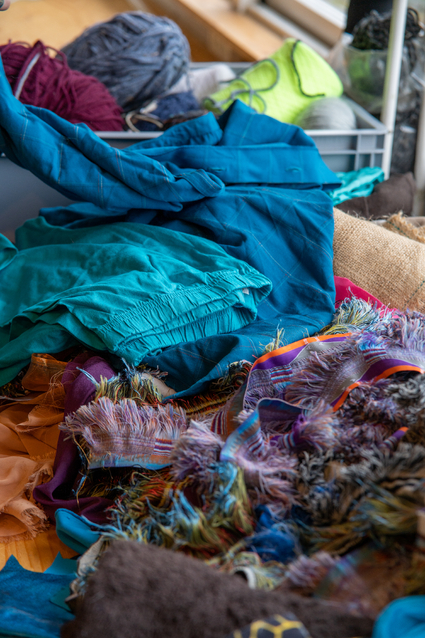
Q: That’s so beautiful, thank you for sharing. Reflecting on your career, how do you feel your designs connect to the themes of neurodiversity?
A: I think literally in every way… I mean, as a neurodivergent person, it’s really in every fiber of what I create. It's also so clear in my way of working. When I’m working on little test pieces, I’m able to hone in on a fabric, and sometimes that’s where it all starts. That's actually how my process started with Monsters Under The Bed. I was just experimenting with this fabric in every single way, I would just be doing this from nine o’clock in the morning until five in the evening. I had a whole board with all my things, and then at a certain point I just picked two and thought “okay, this will work. This is what tells my story”. And now I’m going to create my monsters with it. For me, there’s always this sort of dynamic self– making links on the table and with materiality, I take this and do this and add it to each other. I used every single piece of that fabric to make the monsters.
On top of that, I think also just my story of queerness and neurodivergence. I had no clue how to deal with all these social structures, it's two things that are so difficult to sort of find your way through. And then other people also judging you. In high school in Holland, I feel like two of the biggest slurs are autist and fagg*t. Like, Jesus.
Q: Did you identify with being autistic in high school, or did that come later?
A: I think it was in my second year of high school. It also very much came from me, I was like “Mom, I think there’s more”. I was interested in finding out who I was, and I felt that there was this part of me that I didn’t have the words for yet. So then we did a bunch of tests, and also having dyslexia, the testing circuit wasn’t totally unknown to me. And yeah, that’s when I got a label for it.
Q: What was your experience like at art school, especially as a neurodivergent student?
A: I mean, I love my school. I really had the most amazing four years of my life, and I think it was such a fruitful place for me to grow both as an artist and as a person. I questioned everything about myself, and I found answers for everything I wanted. It was really nice.
But I also know that for a lot of other neurodiverse people in my school, it was really difficult. What they were struggling with there, I had first faced in high school and I was able to start dealing with them there.So going into this new place, I kind of found that I had ways of dealing with the challenges of: how do I deal with the fact that my brain is constantly on? How do I deal with the fact that I'm reading people's emotions, tenfold? You know what I mean? These were all things that I had already started building my toolkit for. So school was amazing.
Q: I think so many of us relate to what you said about having a toolkit, and how much it helps to have one when adapting to new environments. Do you have any insights or advice from your own journey for other students currently navigating the art school environment?
A: I think find the spaces where you feel the most comfortable and hold on to them. And don't be afraid to voice what you need. I think a lot of people are scared that institutions won't listen to them. It’s understandable, because it’s happened a lot where they don’t listen. But I don't think we should stop trying. When we have problems with something, find the teacher you like, talk to that one person that actually hears you and makes the issue heard. I think a lot of institutions are sometimes ignorant to these things, not by choice, but because they literally don't know. Part of our power is voicing these issues and making sure that we are heard.
Clemens Going Through Different Kinds of Fabric -
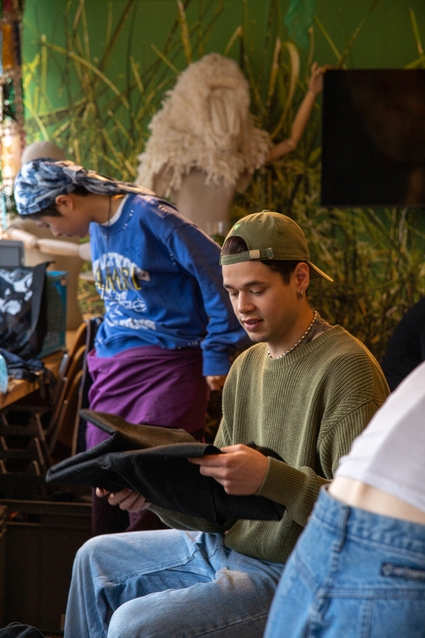
Q: Thank you for sharing all of this with us! Lastly, for anyone who might be interested, what can you share about Mediamatic’s Textile Cafe and your new role here?
A: Yes! So I am the new supervisor of the Lap Lab at Mediamatic. What I really want is to create this sort of community hub where people can come in every Wednesday for the Textile Cafe, learn from each other, help one another, and for the community to shine through. We want to keep bringing in knowledge and sharing it with the next person.It’s just really wholesome, and has almost like a campfire vibe to it. Everyone’s just sitting together, mending, repairing, doing their own thing, but also being there together and having a nice chat.
To hear more about Clemens' practice and his design practice, join us at our next A/artist event: Monsters Under The Bed, at Mediamatic on 15th April 2024.
